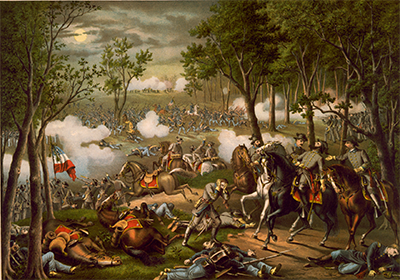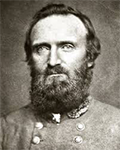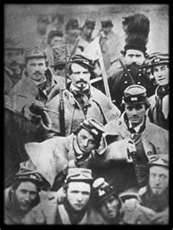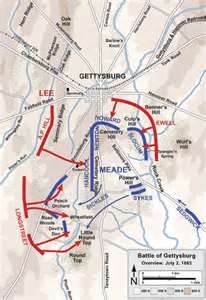Confederate General Robert E. Lee
Hooker spent the spring of 1863 shoring up his force, giving wounded soldiers time to heal and starving soldiers time to replenish their strength, then designed a plan to take Richmond. Meanwhile, in Fredericksburg, the Army of Northern Virginia struggled to maintain supplies. In desperation, Lee dispatched Maj. Gen. John Bell Hood, Maj. Gen. George Pickett, and a large number of troops to range southward in search of supplies. While they were in the field, Hooker's army outnumbered Lee's army 2–1. The troops crossed the river successfully at both points, on April 27 and April 30. As a result, the Union force at Chancellorsville numbered 70,000. Trusting his instinct again, Lee divided his force and, even though heavily outnumbered, ordered his men to attack. 
Despite his reputation for taking the initiative, Hooker chose to dig in at Chancellorsville, trusting in his troops' defensive capabilities. (His commanders had urged him to at least take the nearby high ground, but Hooker demurred.) The one part of the Union army as positioned at Chancellorsville that wasn't as strong as the others was the right flank. It was this point that Stonewall Jackson and his men had reached in the early evening on May 2, by stealing through a woods that concealed their movements. The Confederate attack coincided with mealtime in the Union camp, and the result was a hammer blow for Jackson's troops, including 4,000 captured Union soldiers. The right flank fell back, and confusion reigned in the Union ranks. They did not retreat, however; a brief Union counterattack forced a lull in the fighting. 
Later that night, Jackson (right) wanted to know whether a nighttime attack would work, so he and a few of his troops rode out to have a look. When they returned, a handful of Confederate soldiers thought that they were the enemy and opened fire. Jackson sustained three bullet wounds and ended up having his left arm amputated. As happened so often during this time in history, an infection accompanied the operation, and Jackson died, on May 10. Hooker, meanwhile, became convinced, despite his numerical superiority, that he couldn't win and so ordered a retreat. Lee, working his magic once again, had defeated a larger force by taking a big chance, and it had again paid off. 
After the victory at Chancellorsville, Lee won approval for another invasion of the North. So much of the fighting during the past two years had taken place in the South that Lee, among other reasons, wanted some of the North to feel the brunt of a battle. A peace movement was growing in the North at this time, and Lee also hoped that a great Southern victory in the North would convince other countries, like Britain and France, to send aid to the South. The Army of Northern Virginia, 72,000 men strong, wended its way into the North, aiming to threaten large Northern cities like Baltimore, Philadelphia, and even Washington, D.C., itself. After the loss of Jackson, Lee had reorganized one corps of the army into two, with lieutenant-generals A.P. Hill and Richard Ewell gaining corps commands. Retaining command of the First Corps was Longstreet, architect of the defensive strategy that had been so effective in previous battles. Leader of the cavalry division was Jeb Stuart, who had been a great help in the past by delivering to Lee precise information on enemy movements and strength. The Army of the Potomac, meanwhile, was still strong (at 94,000 men), still under the command of "Fighting Joe" Hooker, and still smarting from the defeat at Chancellorsville. Union troops shadowed Confederate troops for a time, as Lee's army moved through Maryland and into Pennsylvania. This resulted in a few skirmishes along the way, but the main elements of the two armies didn't intersect directly until late June and early July. On June 26, a division of Confederate troops occupied the Pennsylvania town of Gettysburg, strategically placed at a crossroads. The troops, under the command of Maj. Gen. Jubal Early, burned a few railroad cars and a covered bridge and laid waste the telegraph lines and rail lines leading into the town, then left. A few days later, Lee, aware of the relative proximity of Hooker's army, ordered a major concentration of his forces in Cashtown, eight miles west of Gettysburg. Hooker and Lincoln disagreed on how best to confront Lee's invasion force. The result was yet another new commander of the Army of the Potomac, George Gordon Meade. Meanwhile, Stuart and a large part of his cavalry division departed on a reconnaissance mission, to ride around the east flank of the Union army known to be in the area. Stuart's mission took several days to complete. 
More troops from both armies arrived throughout the night of July 1 and the early morning of July 2. Union troops seized control of other hills looking over the town, among them Culp's Hill, Little Round Top, and Seminary Ridge. Meade positioned his troops in a fishhook formation, anticipating that their positions on top of various hills and ridges would give them a good defensive position if attacked. Lee's forces, meanwhile, were arrayed in a wide arc surrounding the fishhook. Stuart and his cavalry were not back at this time, and so Lee did not have an accurate accounting of the Union forces or their positions. Longstreet advised against an assault on what he thought to be a superior Union position. The defense-minded Longstreet preferred to have the enemy come to him. Still, Lee was confident in his troops and in their ability to overcome long odds, as they had done for two years. Lee decided to attack. Despite repeated Confederate attacks, Union troops were still in control of the high ground all around Gettysburg, after two days of fighting. In the middle of the second day, Stuart and his cavalry arrived. They played no meaningful part in the day's fighting. On the third day, Lee decided on a direct frontal assault on the Union positions. After a massive artillery barrage on the Union position, Pickett was to lead 12,500 troops in a straight march across open ground three-quarters of a mile into the teeth of the reinforced Union positions on Cemetery Ridge. Lee counted on a few things to go in his favor:
None of these things happened. Yet again, the superior positioning of the Union forces and the numerical superiority of their weapons and troops to fire them carried the day. The fabled "Pickett's Charge" did result in a handful of Confederate soldiers reaching the Union defenders, but the losses were catastrophic. Lee, his army blown apart by the three days of fierce fighting, opted for retreat from the field of battle. Never again would Confederate troops set foot on Northern soil. Next page > A War of Attrition > Page 1, 2, 3, 4, 5 |
|
Social Studies for Kids
copyright 2002–2026
David White





